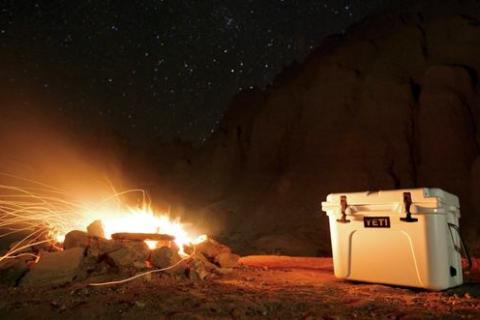
Outdoors enthusiasts can't change the weather, so the only option is to prepare and go with it. Warm weather creates a few tasks for campers, such as keeping drinks and foods cold. The amount of effort required to keep food cold during camping excursions depends on the outside temperature, length of trip and if car camping or packing in. Ice coolers come in hundreds of shapes and sizes, but if one were to be selected from the group to handle a multiple-day camping trip, read the manufacturer's description to locate how many days the cooler can maintain ice. These heavy-duty, superior ice-keeping machines range in quality and price. But what goes into them to create the cold is also an important factor when cold food storage is involved.
 |
| Always read the manufacturer's description on coolers to see how long it can hold ice. |
Cooler models and design have blossomed over the last few years. Major cooler manufacturers offer models built with bodies and lids sporting high-performance insulation. The high-performance insulation and lid sealing design is the combination is the key to these coolers keeping ice for a week or more. A tight sealing lid gasket should be kept clean of debris to ensure a tight fit. From experience, if the ice used in these well insulated coolers are in chunk form (frozen two-liter bottles of water) and if the cooler is covered with a sun ray deflecting material, the ice will last for days. For covering the cooler, use a piece of Reflectix (the foil-faced insulation product), or other sun ray reflecting material such as a windshield protector.
Getting the most out of ice depends on the shape and density. An alternative to water ice is dry ice. Dry ice takes a bit more attention to safely handling the stuff, but the performance of dry ice over water ice is much better. Dry ice is available at most major groceries and super markets and prices start at about $1 per pound. Handling dry ice with gloves is a must as it is twice as cold as water ice. Dry ice is nothing more than frozen carbon dioxide. As dry ice "melts", or sublimates, there is no water mess to contend with. Dry ice simply turns from a solid to a gas. Because of this, coolers and other containers holding dry ice should not be sealed so the gas can escape and not cause a rupture. For most campers, water ice is simple to get, manage and reproduce which is why dry ice is a better choice for campers who have had experience with it. If you would like to give dry ice a go, experiment at home with the same cooler you plan to travel with first.
Keeping camping food cool is not only for enjoying a cool beverage after a day of hiking or fishing, but also to keep food from spoiling. A supply of meat or other cold-stored food gone badly because of an insufficient cooler or ice management could cut the camping trip short — or worse — instill a food sickness that requires medical attention. Don't overlook the task of proper cooler management, as no one wants to raise a lid to find the next meal floating in melt water.
- 5010 views

